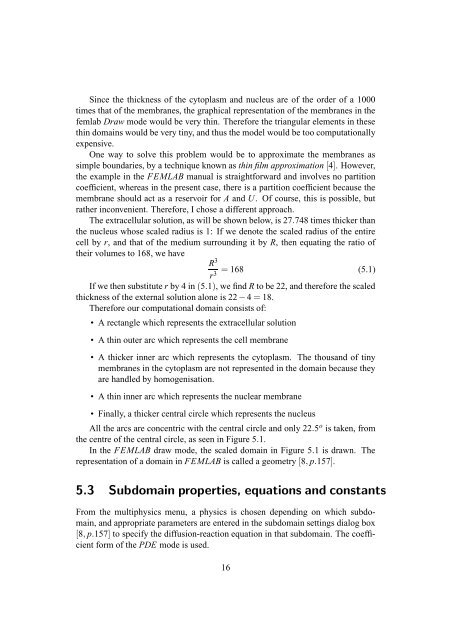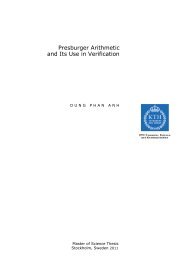FEMLAB - KTH
FEMLAB - KTH
FEMLAB - KTH
Create successful ePaper yourself
Turn your PDF publications into a flip-book with our unique Google optimized e-Paper software.
Since the thickness of the cytoplasm and nucleus are of the order of a 1000<br />
times that of the membranes, the graphical representation of the membranes in the<br />
femlab Draw mode would be very thin. Therefore the triangular elements in these<br />
thin domains would be very tiny, and thus the model would be too computationally<br />
expensive.<br />
One way to solve this problem would be to approximate the membranes as<br />
simple boundaries, by a technique known as thin film approximation [4]. However,<br />
the example in the <strong>FEMLAB</strong> manual is straightforward and involves no partition<br />
coefficient, whereas in the present case, there is a partition coefficient because the<br />
membrane should act as a reservoir for A and U. Of course, this is possible, but<br />
rather inconvenient. Therefore, I chose a different approach.<br />
The extracellular solution, as will be shown below, is 27.748 times thicker than<br />
the nucleus whose scaled radius is 1: If we denote the scaled radius of the entire<br />
cell by r, and that of the medium surrounding it by R, then equating the ratio of<br />
their volumes to 168, we have<br />
R3 = 168 (5.1)<br />
3<br />
r<br />
If we then substitute r by 4 in (5.1), we find R to be 22, and therefore the scaled<br />
thickness of the external solution alone is 22 − 4 = 18.<br />
Therefore our computational domain consists of:<br />
• A rectangle which represents the extracellular solution<br />
• A thin outer arc which represents the cell membrane<br />
• A thicker inner arc which represents the cytoplasm. The thousand of tiny<br />
membranes in the cytoplasm are not represented in the domain because they<br />
are handled by homogenisation.<br />
• A thin inner arc which represents the nuclear membrane<br />
• Finally, a thicker central circle which represents the nucleus<br />
All the arcs are concentric with the central circle and only 22.5 o is taken, from<br />
the centre of the central circle, as seen in Figure 5.1.<br />
In the <strong>FEMLAB</strong> draw mode, the scaled domain in Figure 5.1 is drawn. The<br />
representation of a domain in <strong>FEMLAB</strong> is called a geometry [8, p.157].<br />
5.3 Subdomain properties, equations and constants<br />
From the multiphysics menu, a physics is chosen depending on which subdomain,<br />
and appropriate parameters are entered in the subdomain settings dialog box<br />
[8, p.157] to specify the diffusion-reaction equation in that subdomain. The coefficient<br />
form of the PDE mode is used.<br />
16

















